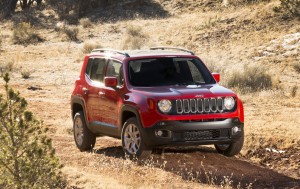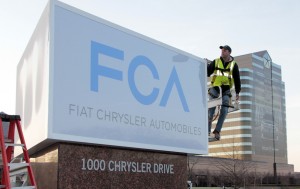
A worker puts the finishing touch on the new FCA sign at the company's North American headquarters in Auburn Hills, Michigan, this morning.
With a veiled reference to the disastrous, failed alliance that nearly destroyed Chrysler during the recent recession, CEO Sergio Marchionne and his management team laid out a broad and ambitious plan for the U.S. maker and its Italian partner, Fiat, that will see the newly merged company roll out a flood of new products during the next five years.
Following up on a day-long session in late 2009, after Fiat first came to Chrysler’s rescue, the new Fiat Chrysler Automobile (FCA) detailed its next five-year plan, outlining a strategy that will see it try to sharpen the focus of each of its many brands. In most cases, that will mean adding a number of new products, though in some cases, key brands like Dodge will actually reduce their line-ups to eliminate models that don’t fit their image.
With several hundred investment analysts and an equal number of journalists in the audience, Marchionne’s clear intent was to show that Fiat Chrysler, currently the world’s seventh-largest automotive manufacturer, is well-positioned to challenge rivals ranging from Toyota to Ford, General Motors to Volkswagen, in an increasingly competitive market.
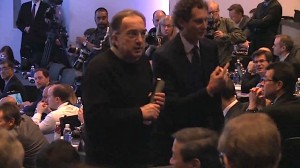
FCA CEO Sergio Marchionne surveys the crowd prior to the maker's meeting where he and other officials laid out the company's 5-year plan today.
“The history of the auto industry is littered with the remains of alliances that failed,” Marchionne reminded his audience as the day-long presentation began, a clear reference to the flawed “merger of equals” pairing Chrysler and what was then known as Daimler-Benz in 1998. That partnership ultimately led to the collapse of the U.S. maker and its eventual rescue from a 2009 bankruptcy by a U.S. bailout approved only after Fiat came in as its white knight.
The first half of the day was spent focused on FCA’s many automotive brands, starting with Jeep, the marque generally credited with not only inventing the sport-utility vehicle, but also transforming it from a specialized product for the military and rugged outdoorsmen into a familiar site in suburban driveways around the world.
Ironically, Jeep has missed out on much of the segment’s explosive growth – but it clearly intends to make up for lost time over the next half-decade. Sales that bottomed out below 400,000 during the depths of the recession were originally expected to climb to 800,000 for 2014. But an emboldened Jeep has boosted its forecast for this year to 1 million, with a target of 1.9 million by 2018, revealed brand CEO Michael Manley.
A key to that growth has been an aggressive push into overseas markets, especially China, which is expected to yield some of the fastest growth in the utility vehicle segment during the decade ahead, according to industry forecasts. Jeep had largely been locked out of China since the collapse of the DaimlerChrysler partnership but the maker last month announced it will soon begin manufacturing vehicles in the market.
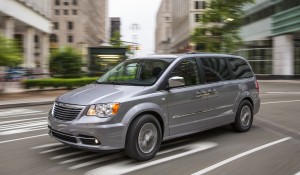
In 2016, the Chrysler Town & Country will be available with an optional plug-in hybrid powertrain expected to yield about 75 miles per gallon.
Until now, Jeep has been producing vehicles solely in the U.S., but will add a number of overseas production operations. The brand’s new compact model, the Renegade, will be produced in Italy.
Along with the upcoming launch of the Renegade, Manley revealed plans to replace the slightly larger Jeep Compass and Patriot models in 2016, followed by a new version of the popular Grand Cherokee a year later. And in 2018, Jeep will launch an all-new Grand Wagoneer, which promises will be the most upscale model it has ever produced.
The Chrysler brand will also see a critical infusion of new product – something it needs to reverse a slump that saw sales slip from a peak of 801,000 sales prior to the recession to just 350,000 units last year.
“Chrysler lost its way,” acknowledged CEO Al Gardner, adding, “its sales reflected a lack of attention and focus.”

Fiat Chrysler Automobiles hosted nearly 400 analysts and media members at the company's Auburn Hills, Michigan location.
The new strategy for Chrysler positions it squarely in the heart of the North American mainstream market, abandoning any pretense of being a luxury, or even premium, brand. Among the brands on the U.S. side of the company, Chrysler will see the biggest infusion of new product, starting with a new small car, dubbed the Chrysler 100, in 2016. The 100 will allow the maker to take on such compact powerhouses as the Toyota Corolla, Honda Civic and Ford Focus.
That same year will bring an all-new version of its long-dominant Town & Country minivan, due out in 2016. Notably, it will be the world’s first people-mover offered with an optional plug-in hybrid powertrain expected to yield about 75 miles per gallon.
Chrysler will also get a plug-in option for an all-new crossover-utility vehicle, or CUV, due to market in 2017. A midsize crossover will follow a year-later, along with a remake of the big Chrysler 300.
All told, the flagship brand is hoping to regain its former sales peak of 800,000 by the time the 5-year plan is completed in 2018.
Chrysler’s gain will be the Dodge brand’s loss, however. Known for muscle cars like the newly updated Charger and Challenger, Dodge will give up its own minivan, the Grand Caravan, as well as the Avenger model, in a bid to more sharply focus on performance products. However, it will get a new small hatchback and sedan model for 2018, along with further updates of existing products. And steps will be taken to add more momentum to the slow-selling Dart, which will be completely updated in 2016.
“The Dodge Brand’s volume will decrease initially,” cautioned the marque’s chief Tim Kuniskis, though the goal is to get back to the 600,000 mark by 2018.
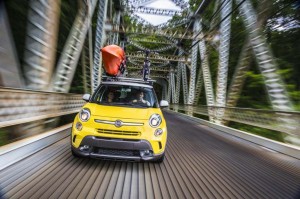
The Fiat 500L is one of the Italian makers products that are coming to the U.S. However, the entire line-up isn't going to be sold in the U.S.
(BMW posts first-quarter profits. For more, Click Here.)
Some of the biggest – but most challenging – targets were laid out for FCA’s Italian brands, especially Alfa Romeo, a marque that has long struggled to overcome decades of poor planning and products that didn’t fit its sporty image, lamented CEO Harald Wester. Its traditional strength on the race track, he noted, “never translated into significant financial success.”
But Alfa is taking a number of steps to gain traction, starting with the unveiling last month of the new 4C sports car at the New York Auto Show marking its return to the American market after two decades.
(New vehicle fuel economy drops in April. For more, Click Here.)
Perhaps more significantly, Wester revealed that Alfa has created a skunk works that will soon be manned by 600 of FCA’s best engineers and designers, charged with developing an all-new array of engines and vehicles. The first new model is expected to reach market by the end of 2015, and there will eventually be eight products in Alfa’s global line-up.
All told, the maker expects to see an investment of 5 billion Euros by 2018, but the payoff could be significant, with sales forecast to grow from 74,000 in 2013 to 400,000 by 2018.
(Click Here to get TDB’s first look at BMW’s new i8 sports hybrid.)
One reason for optimism is the recent success of the long-troubled Maserati brand. An influx of new models, such as this year’s all-new Ghibli and redesigned Quattroporte, have nearly doubled sales from 8,600 in 2008 to 15,400 last year. And Wester, who also heads Maserati, forecasts the numbers will climb to 75,000 by the end of the 5-year plan.
Today, the upscale brand has four products, but that will climb to six soon, including its first-ever SUV. Maserati also plans to introduce a line of new engines that will boost its performance bona fides substantially. The various diesel and gasoline powertrains will deliver as much as 585 horsepower.
(To see more on the new camera system that could reduce fatal truck crashes, Click Here.)
The first name of the newly merged company, the Fiat brand is also facing its struggles, in part because of the unusual dual nature of its product line. Its mainstream European models are losing ground and delivering minimal margins, conceded CEO Olivier Francois. On the other hand, its more stylish models, such as the Fiat 500, continue to gain momentum – and deliver strong margins.
Critical to the brand’s growth will be new products including an all-new crossover, the 500X, sharing the same platform as the recently launched 500L people-mover. A U.S. version will reach market next year. Olivier suggested it should help Fiat double volume in the States to around 100,000 by 2018.
If there’s one brand FCA doesn’t have to worry about growing, it’s Ferrari, which has actually had to put a cap on its sales at 7,000 annually. FCA CEO Marchionne spent time outlining his estimate of the value of the supercar brand – a tease as it turned out. Despite constant rumors Ferrari eventually might be spun off, the executive ended his discussion by stressing that Ferrari is “not for sale,” and won’t be while he’s in charge.

